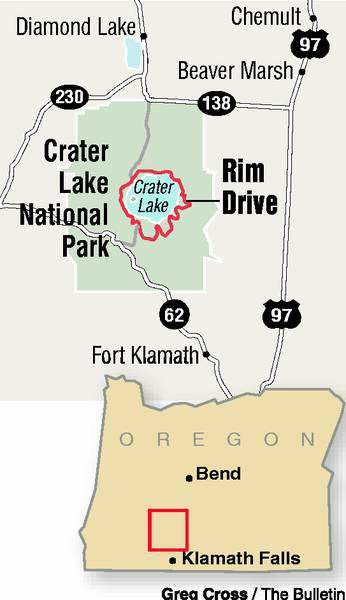Outing: Big, beautiful, blue
Published 5:00 am Wednesday, August 22, 2007

- Vidae Falls is a popular stop along the Rim Drive at Crater Lake National Park.
The water is so blue.
I take it on faith that it’s actually water. From up top, it’s an other-worldly azure, somehow better than blue, but I’d have a hard time pinpointing the precise quality that makes it so. It reminds me of the picture on an expensive, high definition television screen, but not quite. Or a scene through one of those 3-D stereoscopic viewers, but that’s not it, either.
People have been trying to describe Crater Lake for hundreds of years, and the best most can do is “wow” or “aah” (or the monosyllabic American Indian equivalent).
At 1,943 feet, Crater Lake is the deepest in the United States. According to the National Park Service, “Light gets absorbed color by color as it passes through clear water. First the reds go, then orange, yellow, and green. Last to be absorbed are the blues. Only the deepest blue gets scattered back to the surface, where you see it as the color of the water. The water is, of course, no more blue than the sky is blue.”
Yeah, right.
Crater Lake was formed a mere 7,700 years ago when Mount Mazama blew its top, scattering ash over eight states and three Canadian provinces. Ash lies 50 feet deep in Crater Lake National Park’s Pumice Desert, and there’s a lot of it in the topsoil of Central Oregon.
When the eruptions wound down, there was nothing left for the volcano to do but collapse. About 5,000 years ago, springs, snow and rain began to fill the caldera. Today, evaporation and seepage balance the incoming flow of water. If it really is water.
The sheer magnitude of the Crater Lake experience can send the human mind on extended flights of fancy.
A colleague of mine suggested that if there’s not a dragon or mythical monster lurking in the barely fathomable depths of Crater Lake, there ought to be. A grizzly bear that sprouted gills and preys on God knows what way down there.
Or a freshwater shark that grows to ghastly proportions and scares the bejabbers out of park visitors on its rare forays to the surface of the 5 trillion-gallon lake.
We weren’t the first to think about this kind of thing.
The 1977 movie, “The Crater Lake Monster,” had a meteor crashing into the lake, which incubated a prehistoric egg. The baby plesiosaur grew to ghastly proportions and terrorized the community.
But the reality is that Crater Lake National Park is an American treasure right here in Oregon. If you’ve never been, this month or next is the time to do it. If you want to spend a whole day, drive all the way around and take a few side trips on foot. The last time I was there, in June during a healthy snow year, the Rim Drive was still closed (the winter is a good time to ski there and experience that season’s beauty at 6,450 feet).
This time around, the 33-mile Rim Drive was clear sailing, and we stopped at all 30-plus pullouts for a slightly different perspective and a photograph. My mother-in-law, Helen Holder, who lives in Maryland, was enthralled with the lake and the Castle Crest loop trail that swings through a dark forest of fir and hemlock, then opens onto a sunny meadow on the back side. The meadow was full of wildflowers, freshened by myriad springs on the hillside, but the show peaked a couple of weeks ago. Allow as much as an hour so you can stop every so often and soak it all in.
On the Rim Drive, you can check out Wizard Island from just about any overlook you choose (Watchman on the west shore is closest), and Phantom Ship, the lake’s “other” island, on the east side. The 400,000-year-old rock structure looks more like a castle than a ship, but it’s captivating either way.
Vidae Falls is a cascading waterfall on the south end of the lake that, even in late August, is a good place to photograph Indian paintbrush and other wildflowers flourishing in the moist environment.
If you get to the park early enough (7:30 a.m. is a good bet on a summer weekend), you can buy a ticket for a boat tour of the lake ($25.50 for adults, $15 for a child 11 and younger). The tour involves a 1.1 mile hike down to (and back up from) the Cleetwood Cove boat dock; tours typically leave the dock at 10 a.m., 11 a.m., noon, 2 p.m. and 3 p.m. Contact: 594-3000.
We finished our day at the Crater Lake Lodge, a historic old building with a charming restaurant and renovated rooms. Not surprisingly, the view of the lake from the veranda was breathtaking, stunning, awe inspiring.
Three hundred feet below, the surface of Crater Lake seethed with the sepulchral depth of a billion opulently blue sapphires.
Almost. But no.






